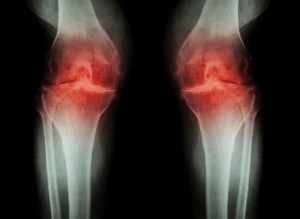
Osteoarthritis (OA) is a major cause of disability worldwide and according to “The global burden of hip and knee osteoarthritis: estimates from the Global Burden of Disease 2010 study“, OA of the knee is the 11th highest contributor to global disability. Put simply, millions of lives are affected by the disease every single day. It is predicted that it will advance to become the 4th leading cause of disability by 2020.
The cause of knee osteoarthritis is complex and certainly multi-factorial in nature. There is a great summary over on Physiopedia, but in brief, it is a complex interaction between systemic and local factors. These factors include: advancing age, genetics, trauma, knee malalignment, increased biomechanical loading of joints through obesity, augmented bone density and an imbalance in physiological processes. It has been frequently reported, and it is a common thought, that obesity and advancing age are the two critical, and biggest, contributors to increasing prevalence of OA. This belief is being challenged by new evidence which may suggest that perhaps we have been approaching our understanding from the wrong perspective.
A novel study entitled “Knee osteoarthritis has doubled in prevalence since the mid-20th century” investigated the long-term historical trends of knee OA prevalence in the US from the past 6000 years. This data was collected through the use of historical records, cadaver studies and human skeletons from thousands of years ago (for the nitty gritty details please go to the original source!). Their results indicated that “…increases in longevity and BMI are insufficient to explain the approximate doubling of knee OA prevalence that has occurred in the United States since the mid-20th century. Knee OA is thus more preventable than is commonly assumed, but prevention will require research on additional independent risk factors that either arose or have become amplified in the postindustrial era“.
Obviously retrospective studies cannot directly test causation, and there could be a number of factors at play, but the authors attribute environmental factors as the biggest contributor. Therefore, OA knee is more easily preventable than initially thought. Considering that loading is likely to be the biggest contributor of OA knee, through abnormal loading or weak structural tissues, joint loading is a topic worth investigating. As the authors explain, footwear, pavements and BMI could all be plausible risk factors. However, they see physical activity as the most important change across history and likely to be key to understanding why prevalence has doubled.
Less physically active individuals who load their joints less develop thinner cartilage with lower proteoglycan content (34, 35) as well as weaker muscles responsible for protecting joints by stabilizing them and limiting joint reaction forces (36). Chronic low-grade inflammation, which is exacerbated by physical inactivity (37), modern diets rich in highly refined carbohydrates (38), and excessive adiposity (10), can further magnify and accelerate loading-induced damage to joint tissues and may also directly affect knee OA pathogenesis (5). Evaluating which of these or additional features of modern environments are responsible for today’s high knee OA levels is necessary. (Wallace et al 2017).
This study highlights the direction modern physiotherapy should adopt. We should use studies like this to empower our patients. Clearly there are caveats to a study of this kind, however we should not let that affect it’s clinical significance. We should not let our patients believe OA knee is an inevitability of getting older or becoming overweight; people can do something about it. As physiotherapists, we have proven the effectiveness of management of OA knee through the mediums of lifestyle advice, education and exercise, just as this study suggests. Let’s be proactive not reactive. We need to further promote the importance of exercise and we should aim to correct joint loading through strength and proper technique to enable people to stay stronger for longer.
As a recent tweet by Anna Lowe demonstrates, we need to get better at advising our patients to become more active, more exercise focused and stronger. The implications of leading an exercise-centric life are evident, well documented and overwhelmingly positive. Let’s get to work.
Similar findings in our survey; few physios know the PA guidelines @PhysioChris @thecsp @exerciseworks https://t.co/vqaDvWjpM0
— Anna Lowe (@annalowephysio) August 15, 2017
No comments:
Post a Comment